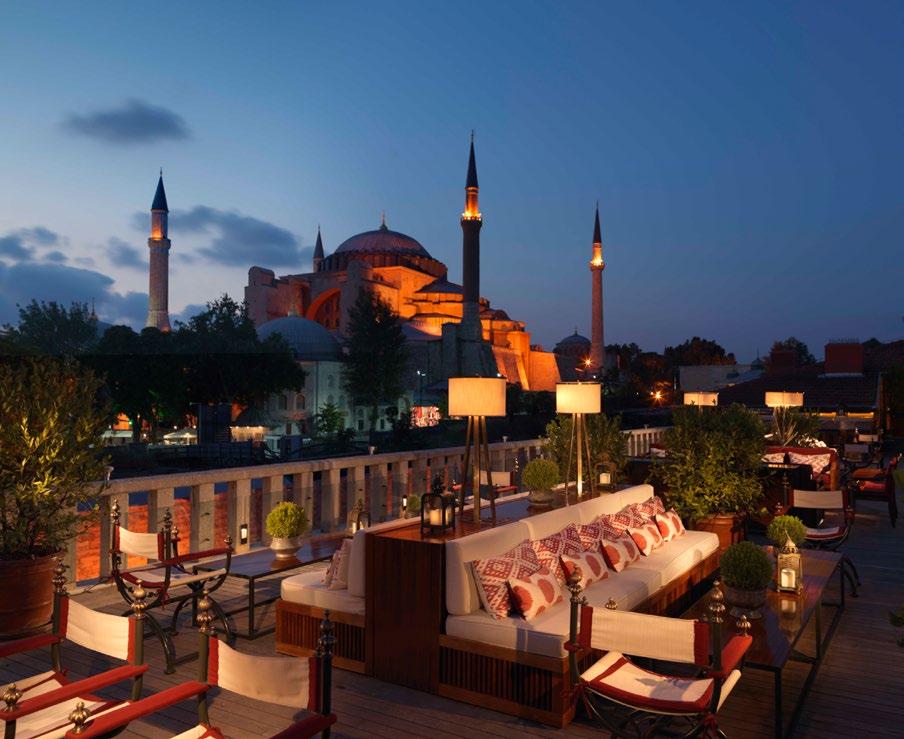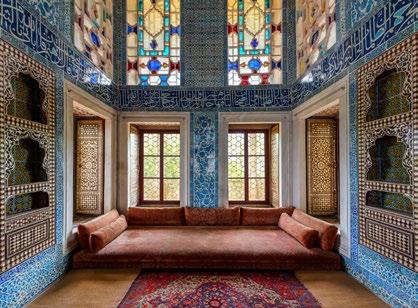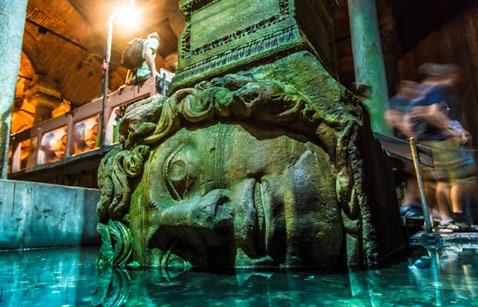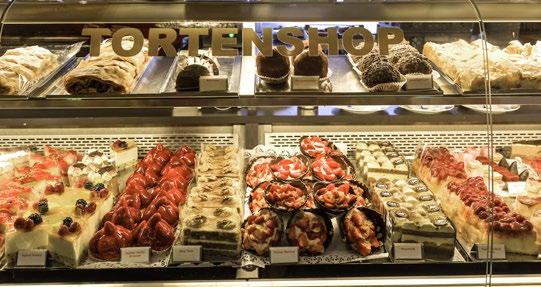
9 minute read
İSTANBUL


Advertisement
History and Hospitality
İstanbul draws meeting goers from around the globe. BY RICHARD NEWTON
In the year 381, when a global council Downtown, the seven-story Istanbul of Christian bishops convened, there Congress Center, or ICC, situated a short walk was only one logical place for them to from the central Taksim Square, offers 115 fully meet. From all corners of the Christian equipped meeting rooms; nine meeting halls with world they converged on Constantinople (now capacity of up to 1,300; and an auditorium that İstanbul) in what could be regarded as one of the can seat 3,705 people. world’s first MICE events. Next door to the ICC, Lütfi Kırdar For millennia, this city represented the International Convention and Exhibition Center, geographical center of the human world. Situated known as ICEC, includes 45 versatile meeting on both banks of the Bosporus, the channel that rooms; a 2,000-seat auditorium; and magnificent links the Black Sea to views from its hillside location down to the the Mediterranean, Bosporus.
AS YOU WOULD EXPECT OF A the city straddles the The Haliç Congress Center is picturesquely
MAJOR INTERNATIONAL CITY, continental divide between Europe and located beside the Golden Horn, the estuary dividing the European side of İstanbul in two.
İSTANBUL IS WELL-SERVED BY Asia and stands as a Although slightly off the beaten path with regard
HIGH-END INTERNATIONAL crucial staging post between Northern to tram and Metro links, visitors can easily reach the center by bus or taxi and, uniquely among the
HOTEL CHAINS, MANY CATER- and Eastern Europe major venues, also by ferry (the adjacent Sütlüce
ING TO THE MICE SECTOR. and all points south. ferry stop is part of the city’s busy ferry network). Through the rise The center comprises several buildings, each and fall of empires, boasting auditoriums and meeting rooms. The through the shift from Christianity to Islam and Erguvan Restaurant, overlooking the water, can through a change of name, İstanbul’s strategic accommodate up to 200 guests. importance remained constant. With the advent As you would expect of a major internaof the modern MICE sector, the city instantly tional city, İstanbul is well-served by high-end established itself as a major destination. international hotel chains, many catering to İstanbul’s claim to be the crossroads of the the MICE sector. The Grand Hyatt Istanbul, Cultural world was reaffirmed with the October 2018 located downtown close to Taksim Square, offers Crossroads: opening of the new Istanbul International 21,000 square feet of flexible meeting and event Aya Lounge at Four Seasons Istanbul at Sultanahmet (top), Airport, 21 miles northwest of downtown. With an anticipated annual capacity of 200 million space. The nearby Ritz-Carlton features similarly flexible event space (with panoramic views of the
Topkapi Palace passengers by 2028, it would be one of the Bosporus) and provides a Technology Butler to interior mosaictiled walls (bottom world’s busiest aviation hubs. ensure everything runs smoothly. left) and Medusa İstanbul boasts a wealth of state-of-the-art The city boasts two Four Seasons hotels. The head in the Basilica MICE venues. By far the largest is CNR EXPO, one in the historic Sultanahmet district proves
Cistern (bottom right) close to the old Atatürk International Airport an ideal incentive base for visits to such iconic (closed in 2019 and now serving general avia- attractions as the Topkapi Palace and the Hagia PHOTOS: © FOUR SEASONS ISTANBUL tion and cargo). This large facility, with eight Sophia, while the other, occupying a larger site AT SULTANAHMET, © SJANKAUSKAS | exhibition halls totaling more than 1.6 million on the Bosporus shore, has a range of halls and DREAMSTIME.COM, © SERGII FIGURNYI | square feet, will continue to benefit from the rooms for meetings and events. From the hotel’s DREAMSTIME.COM Metro and other transport links originally waterside terrace you can watch the comings established to serve the old airport. Three and goings on the busy waterway — a reminder additional halls in the complex are operated by İstanbul has always been, and continues to be, one World Trade Center Istanbul. of the world’s great meeting places.
UNIQUE VENUES
On the surface and beneath, the Romans, Byzantines and Ottomans all left their mark on İstanbul. The great Byzantine cathedral, Hagia Sophia, proves the ultimate example. Originally built in the sixth century, it was turned into a mosque in the 15th century, converted into a museum in 1935 and again designated as a mosque in 2020. In the shadow of this great building sits one of the city’s more unusual venues, a 16th-century bathhouse, the Ayasofya Hürrem Sultan Hamami. Small groups can enjoy bath and massage offers followed by a meal in the atmospheric courtyard restaurant (please note the bathhouse itself is segregated into male and female sections).
ayasofyahamami.com
The Sait Halim Paşa Mansion, an ornate Ottoman palace on the European waterside of the Bosporus, offers a prestigious venue for weddings and corporate events. With 13 function areas, the mansion can accommodate small groups or cocktail parties of up to 1,600 guests.
saithalimpasa.com
Among İstanbul’s great subterranean attractions are its Byzantine cisterns — underground reservoirs — dating back to the fourth century. The Basilica Cistern is the largest and most famous, a must-see visitor attraction. The second-biggest, now known as the 1001 Direk Cistern, has been drained of water, subtly modernized and transformed into a characterful venue capable of hosting up to 3,000 people.
yerebatansarnici.com icvb.org.tr/venue/yerebatan-cistern

Grande Dame
Venture out in Vienna, a city of opulence and grace.
BY ANGELIQUE PLATAS
Artistic Ambience:
Beautiful interior of the café inside Kunsthistorisches Museum
PHOTO: © RADIOKAFKA | DREAMSTIME.COM Brewing long and deep at its center before radiating out to the rest of Europe, Vienna boasts an illustrious history and lasting intellectual impact. The Austrian capital dates back to Celtic and Roman rule, the latter inhabitants using the center city as a military hub among many other employments.
Situated on either side of the Danube River, the city’s well-positioned location allowed for trade to prosper, quickly followed by Baroque masterpieces of architecture and culture replacing the city’s humble medieval beginnings. The city’s dense center began to expand and elevate its own societal position. Dividing walls and small houses came down while palaces, parliament buildings and centers for the arts went up — along with Vienna’s population. A bustling, grand city emerged with a whole new genre of music in tow.
While certainly shaped by imperial history, industry and location, Vienna has its people to thank for its unwavering reputation as an artistic hub. The city’s immense cultural contribution to all of Europe can easily be pinned to its musical past and players. Composers and musicians from all over Austria and Germany found themselves in Vienna playing, teaching and inspiring the masses. Even the least musically inclined individuals may know Viennese residents and masters such as Joseph Haydn, Wolfgang Amadeus Mozart, Ludwig van Beethoven, Franz Schubert, Johannes Brahms, Johann Strauss I and II, as well as Gustav Mahler and many others — while not all originally having hailed from Vienna or even Austria, all found their way to the city for music.
Decades turned into near centuries of brilliant composers, musicians and masters making their way to Vienna, adding to the Viennese musical tradition spanning the late 1700s to well into the 1900s. With music drawing so many to Vienna’s cultural center, the city’s landscape adapted quickly to keep up and provides a stunning peek into the past to this day.
When in Vienna, one can’t help but think of music and culture — the city overflows with them. Reveling in the city’s grand allure, it’s easy to find yourself in a different corner café each day — as one should — channeling the minds and moods of historic masters who once roamed the streets and took social shelter in the same locales many business travelers visit today. A must for any traveler in the area: a power breakfast or strategic lunch meeting at a café, with an obligatory tourist stop or two around the city to entertain.

Indulgence: A rich dessert and coffee served at the famous Café Landtmann (top), Vienna cakes at Café Landtmann (middle), and desserts at Café Sacher (bottom)
PHOTOS: © AARON FRUTMAN | DREAMSTIME .COM, © SUSE SCHULZ | DREAMSTIME.COM, © EVGENIY FESENKO | DREAMSTIME.COM
In Austria a 38- to 40-hour work week is standard, but family dinner remains essential — meaning business ventures usually wrap up around 5 p.m. Restaurant operating hours tell another story, many opening 11 a.m.–2 p.m. for late breakfast and early lunch to then reopen for dinner 6–10 p.m., or occasionally as late as 11 p.m..
Coffee houses and cafés in Vienna are a way of life. Once a social hub for intellectuals, many of the city’s cafés date back to the 19th century, and the tradition remains the same — cafés are the place to be. The oldest café, dating back to the late 1600s — once a medieval bathhouse and later a venue for performances by both Mozart and Beethoven — Café Frauenhuber should be an absolute must on your list.
Another great meeting space, Café Landtmann dates back to the 1800s and adapted to the times quite well, offering takeaways and converted indoor-outdoor dining space for guests to grab-and-go and see the sights or linger and enjoy the city view. Make your way through the city’s iconic coffee houses, paying homage to the greats and stunning city landscape around you, from Café Prückel and Fenster Café to Café Diglas near St. Stephen’s Cathedral. Should you need a bit more space, time and ambience, make your way to the water and enjoy an all-day menu at Café & Restaurant Motto am Fluss, closing at 11 p.m. If you’re lucky enough to get a reservation for dinner, check out Wratschko Gastwirtschaft — if for no other reason than the establishment was made famous by Anthony Bourdain’s visit. This stop offers eclectic Austrian cuisine and a laid-back atmosphere, but for something a bit more impressive, anything in Vienna’s Hotel Sacher should do the trick. Enjoy coffee and pastries in an elevated diner scene at Sacher Eck Vienna, or book an impressive reservation at the hotel’s equally opulent Restaurant Rote Bar or Restaurant Grüne Bar, offering Viennese specialties and creative innovations, respectively. If you’ve gotten your client this far, there’s always a chance for a nightcap at Blaue Bar. Shrouded in rich blue hues and dripping in opulence, this space offers a swanky step back in time. For something slightly tongue-and-cheek and casual, venture back out into the city and find a street-side table at Pfiff & Co, an American-style bar offering beer and light bites. Venturing on foot through Vienna exposes any visitor or local to an impromptu walking tour, passing historic buildings and iconic music halls. The city winds and opens up into different cultural corners, and it can often feel like groupings of bygone neighborhoods have been layered upon each other. While opulence and grandeur is an architectural theme, the charming proximity offers a more friendly feel than many cities allow.









